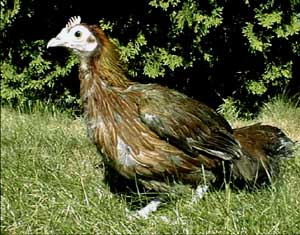|
Avian Flu Fighters Could
Benefit from Cracking of Chicken's Genetic Code

|
Researchers have unraveled the genetic
sequence of the Red Jungle Fowl, an ancestor of domestic chickens.
(Photo courtesy National Human Genome
Research Institute)
|
By Lisa D. Tossey
Maryland Newsline
Tuesday, March 9, 2004
A team of
international scientists announced last week that it has cracked the
chicken’s genetic code, a development that could aid in the fight against avian
flu.
The
researchers have assembled the genome of the Red Jungle Fowl (Gallus
gallus), an ancestor of domestic chickens, and have placed the genetic
sequence in a public database for use by other scientists.
It is the
first bird genome to be completed, and includes about 1 billion base pairs
of DNA, the molecules that carry genetic information necessary for the
organization and functioning of most living cells. By comparison, the human
genome spans about 3 billion pairs.
The research
team, led by Richard Wilson of the Washington University School of Medicine in St.
Louis, is now “annotating, filling in the blanks and analyzing” the initial
assembly of the sequence, said Geoff Spencer, a spokesman for the National
Human Genome Research Institute, which funded the research.
“Even in a
rough draft form, it can help,” Spencer said. “Research will be accelerated
by having this tool.”
Recent
outbreaks of avian flu throughout the world have increased interest in how
genetic variation plays a role in the resistance levels of different birds.
Researchers will now be able to use the genome to identify genes that might
help chickens ward off various strains of the flu, they say.
Mo Saif, a
poultry disease expert with the Ohio Agricultural Research and Development
Center, said having the sequence will aid research in finding chickens that
have such resistance. But he warns: “The benefits will not be immediate. The
more accurate and inclusive the sequence becomes, the better.”
Poultry
farmers in Maryland were on edge following a weekend avian flu outbreak in
Pocomoke City, Md. The strain of flu found on the Worcester County farm,
known as H7, does not pose a threat to people but can be deadly to the
birds. It is the same strain that was found on two Delaware poultry farms
last month, said
Julie Oberg, a spokeswoman for the Maryland Department of Agriculture.
Oberg said
118,000 birds were humanely killed on the affected farm Sunday. Another
210,000 birds that tested negative for the flu on a related farm will be
destroyed as a preventative measure.
The poultry
industry is Maryland’s largest agricultural sector, accounting for 31
percent of the state’s $1.4 billion agricultural industry, Oberg said.
Nationwide, Maryland ranks seventh in broiler production, she said.
In addition
to their role in farming, chickens are also widely used in biomedical
research and as a model for studying embryology and development. The
Washington University team has lined up the Gallus gallus genome with
the human genetic sequence, allowing scientists to compare them. By
examining the two genomes, researchers can to look for similar gene
sequences that can help them develop new ways to combat human disease.
Copyright ©
2004 University of Maryland Philip Merrill College of
Journalism
Top of Page | Home Page
|
